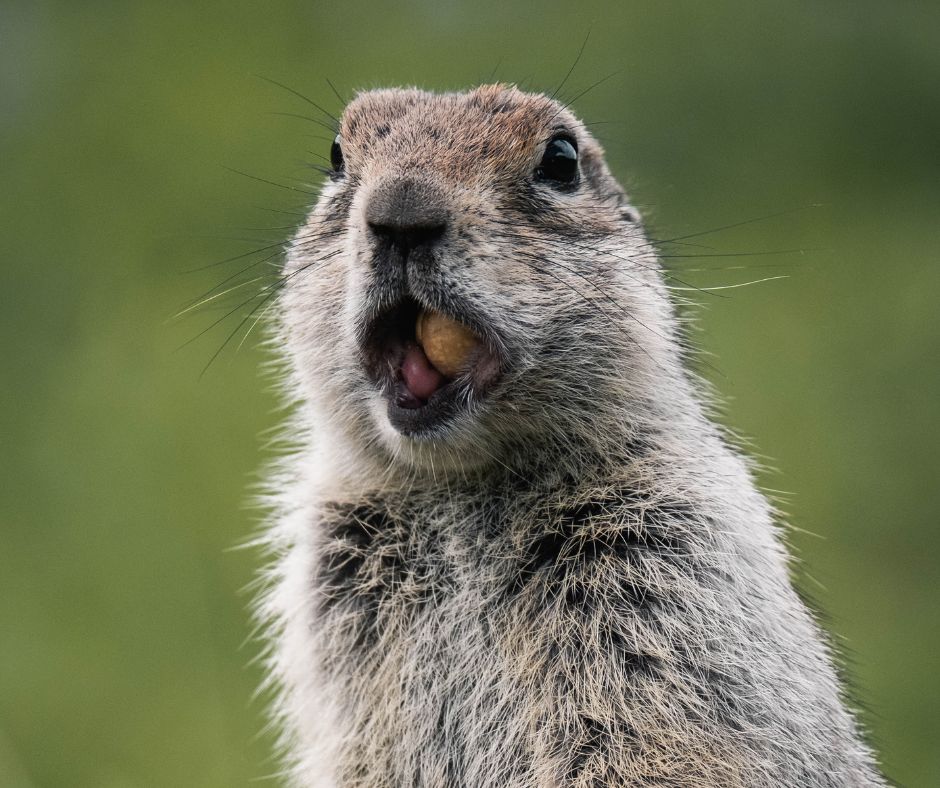 Are Groundhogs Tearing Up Your Yard? Here’s What You Can Do
Are Groundhogs Tearing Up Your Yard? Here’s What You Can Do
Are Groundhogs Tearing Up Your Yard? Here’s What You Can Do
Are you noticing soft, weak ground in your yard, a torn-up garden, large mounds of dirt, and holes underneath your deck or porch? You might have a groundhog problem. Groundhogs are a common nuisance wildlife in the Westchester, NY area during the spring and summer. It’s important to deal with a groundhog problem as soon as possible, as their destructive burrowing and feeding habits can quickly decimate your lawn and garden. This blog can help you recognize the early signs of a groundhog problem, as well as what steps to take so you can act fast and protect your lawn.
Why Groundhogs Love Your Yard
Groundhogs love your yard because it provides them with plenty of sources of food and shelter. Groundhogs are primarily herbivores, feeding on grass, garden vegetables, fruit, flowers, and ornamental plants, however groundhogs may also eat bird eggs and insects. Either way, whether it’s from a lush vegetable garden, a bird’s nest, or some insects passing through, your yard has what groundhogs are looking for.
Your yard also provides the perfect place for groundhogs to dig out their extensive burrows. Groundhogs nest in aerated soil to create temperature regulated homes that offer protection from predators like foxes and coyotes. Groundhogs usually prefer soil that’s loose and not too rocky for their burrows, and many landscaped yards can provide them with exactly that. Digging underneath solid structures like your deck or porch provides them with more cover and protection against predators, and they can also absorb more heat from your home’s foundation this way.
Signs That You Have A Groundhog Problem
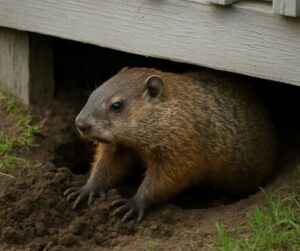 Some of the common signs that you have a groundhog problem in your yard in Westchester include:
Some of the common signs that you have a groundhog problem in your yard in Westchester include:
- Burrow entrances: groundhogs leave behind large holes at the entrance to their burrows, sometimes as big as 10-12 inches wide. You might also spot mounds of dirt nearby that were kicked up by the groundhog while digging.
- Missing garden plants: groundhogs will tear through your vegetable garden, happily taking all your hard work for themselves.
- Chewed flowers: groundhogs will also chew up flowers and other ornamental plants in your yard or garden.
- Weak or soft ground: groundhogs will quite literally hollow out your yard to dig their multi-chambered burrows. The ground above a burrow can feel weak or soft, like it might cave in at any time.
- Holes near foundation, deck, porch, or shed: groundhogs like to nest underneath your home’s foundation, deck, or porch, or underneath a shed, as these structures provide greater cover. Seeing large holes in the ground near the base of these structures can be a warning sign that you have groundhogs burrowing underneath them.
The Risks of Ignoring A Groundhog Problem
Groundhogs don’t go away on their own, and if you have a groundhog problem left unchecked, it can lead to serious consequences. Groundhogs can cause structural damage to your foundation, which can lead to it cracking and settling, which can lead to other issues like water damage and termites. If groundhogs are digging underneath your deck, it can cause the deck to slowly sink into the earth. Groundhog tunnels can also lead to cave-ins, which are a serious safety hazard. If you’re walking over a groundhog tunnel when it caves in, you can trip and may hurt yourself.
If you have a flourishing vegetable garden, groundhogs can destroy your crop yields year after year if they are not dealt with. It can make all your hard work feel like it’s going to waste when a groundhog is able to steal your tomatoes or carrots before you get a chance to try them. The same goes for flower gardens, or any other ornamental plants.
Why DIY Groundhog Deterrents Often Fail
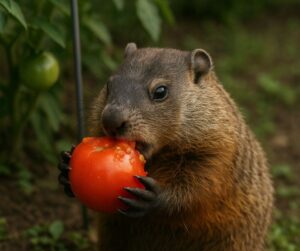 There are plenty of Do-It-Yourself deterrents for groundhogs on the market in Westchester, but some of them might not work as well as you want them to. Devices that use light, reflection, noise, or vibration might scare groundhogs off initially, but they will just come back once they realize there is no real danger. The same applies for scent-based repellents like castor oil.
There are plenty of Do-It-Yourself deterrents for groundhogs on the market in Westchester, but some of them might not work as well as you want them to. Devices that use light, reflection, noise, or vibration might scare groundhogs off initially, but they will just come back once they realize there is no real danger. The same applies for scent-based repellents like castor oil.
Unfortunately, DIY groundhog trapping also might fail, as groundhogs are very clever, and can evade traps set by a newcomer. Novice trappers can even make it harder for professional trappers, as they might be inadvertently training groundhogs to avoid common trapping methods. Don’t worry, if DIY groundhog removal/deterrent methods fail you, Westchester Wildlife is here to help.
Who To Call To Remove A Groundhog In Westchester
If you have a groundhog nesting on your property in Westchester, your best bet is to call a professional nuisance wildlife removal service like Westchester Wildlife. Animal control will only deal with animals that are on public areas like roads or parks, or animals that pose a direct safety threat like a rabid raccoon. For animals causing a nuisance like a groundhog burrowing under your porch, call Westchester Wildlife.
Humane and Effective Groundhog Removal in Westchester
If you are noticing groundhogs tearing your garden up and destroying your lawn in Westchester, contact the professionals at Westchester Wildlife for humane, effective groundhog trapping and removal services. Our technicians have years of experience dealing with groundhogs, so you can rest assured that we can catch these clever little critters. After the groundhogs are gone, we can provide you with wildlife fencing around the perimeter of your yard, around your foundation, or underneath your deck or porch, buried a few feet deep to keep groundhogs from digging underneath it. Contact our crew to get started today with a FREE estimate at (800) 273-6673!
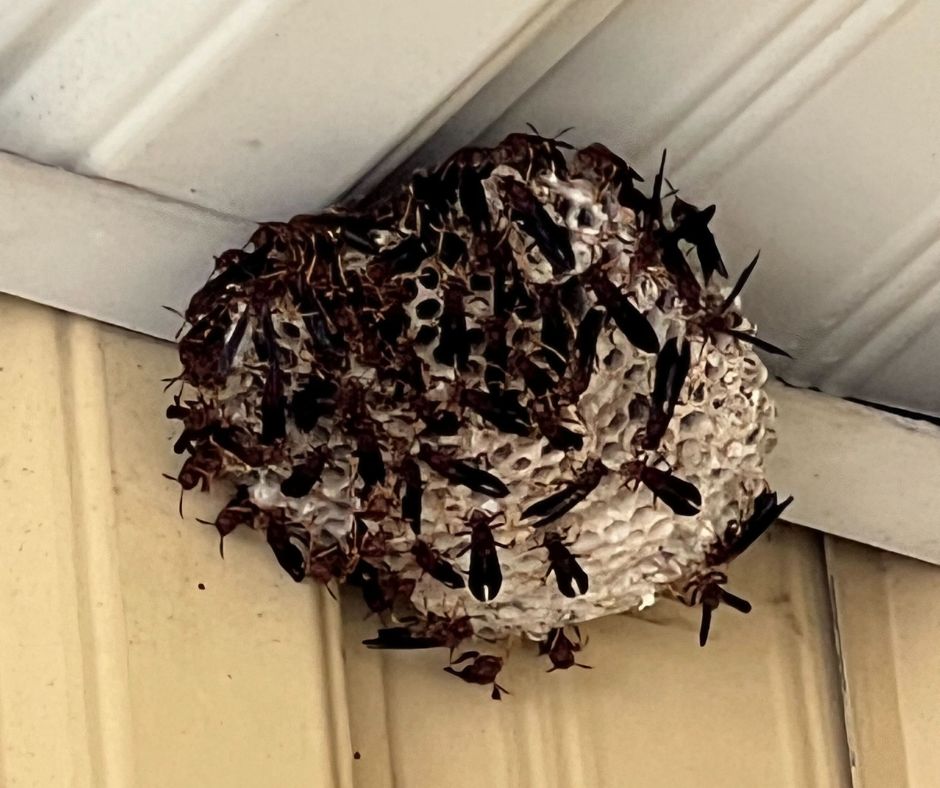 Your Guide to Spring Wasps and Hornets
Your Guide to Spring Wasps and Hornets
Your Guide to Spring Wasps and Hornets
During the springtime, stinging insects like wasps and hornets will build nests on your deck or porch, on your eaves, and even inside your attic space. Wasps and hornets are known for delivering painful, powerful stings, more than once, whenever something gets too close to their nest. This can be a serious issue when they are nesting on your property, and attempting to remove their nests yourself can be dangerous, as wasps and hornets will often swarm, delivering dozens of stings. If you have stinging insects nesting on your property, contact the experts at Westchester Wildlife for professional wasp and hornet nest removal services today. Our team of technicians are armed with the proper tools and training to safely remove wasp and hornet nests without any stinging incidents.
Types of Stinging Insects in Westchester County
Westchester County is home to several different types of stinging insects that can come into conflict with people, including:
- Paper Wasps: These wasps are large, often colored black and yellow, brown, or orange, with a thin waist and long legs that hang down while they fly. Paper wasps create nests out of paper and saliva that hang in an upside-down umbrella shape on porches, decks, vents, attics, and garages
- Yellowjackets: smaller wasps that are bright yellow and black, known for their aggression, painful stings, and tendency to swarm. Yellowjackets will build their nests high up in trees, or underground, near your foundation. You might spot yellowjackets flying in and out of a hole in the ground near your foundation.
- Bald-faced hornets: black-and-white hornets that build their large paper nests on the corners of homes, on light fixtures, or inside attics.
- Mud daubers: very thin black wasps with yellow legs that can be found inside wood siding or shingles. Mud daubers are aggressive, and should be avoided.
How To Keep Wasps Away From Your Home and Yard
If you want to keep wasp nests out of your attic space, the best thing to do is to have a licensed professional inspect your roof, soffit, fascia board and rake board for any potential gaps or cracks that could allow wasps in, and then sealing and fortifying these potential entry points. Keeping wasp nests off your porch, deck, or trees are a bit more difficult. Wasps are attracted to leftover garbage, food sources, and any water they can find, so sealing off your garbage cans, storing and disposing of food properly, and removing bird baths and other water sources can help make your yard less inviting to wasps and hornets.
The best way to keep wasps and hornets away from your yard is to have a regular pest control program done to deter stinging insects from building nests near your home.
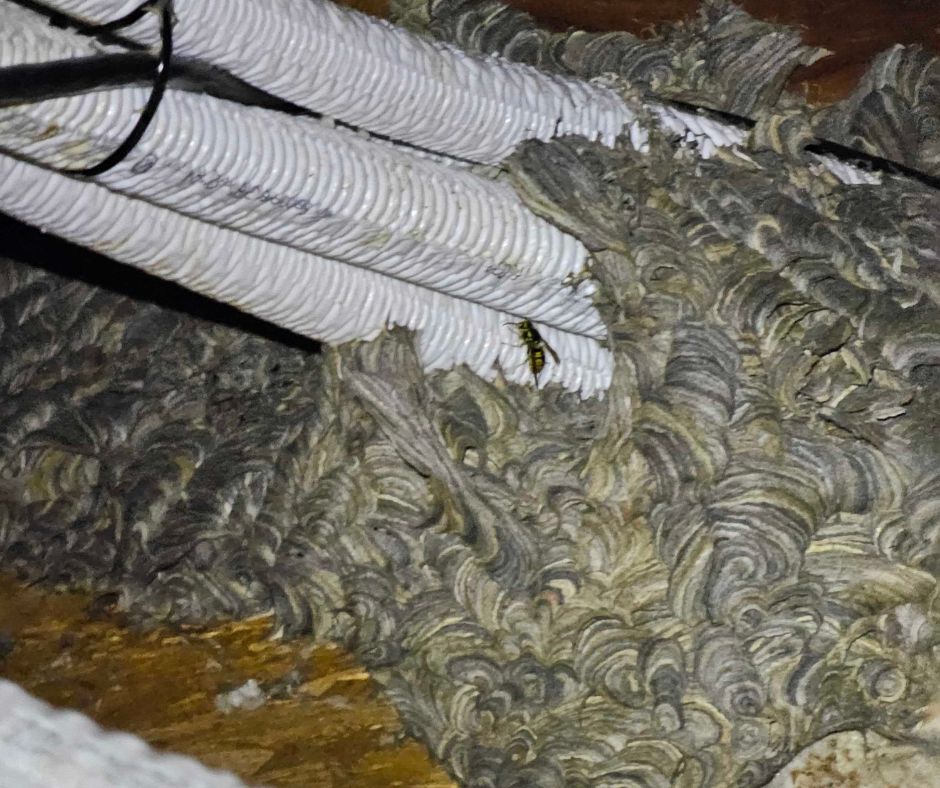
What To Do When You Find a Wasp Nest
When you spot a wasp or hornet nest on your property, it’s important not to disturb it. Wasps and hornets are both known for their aggression, and if you disturb their nests, they may swarm and sting you. DIY wasp removal can be very dangerous, and even life-threatening if you are allergic to wasp venom. Unfortunately, many DIY wasp control products are ineffective, or can be dangerous to the ecosystem if applied incorrectly.
The best thing to do when you find a wasp nest is to call a licensed wildlife removal company like Westchester Wildlife. Our team is highly trained, and has the tools and chemicals needed to safely remove wasp nests from your home without any stinging incidents. The best part is, most wasps and hornets can still sense a wasp nest used to be there, and will tend to avoid building a nest in the same location.
Best Wasp and Hornet Removal in Westchester County
Wasps and hornets are a very common sight in Westchester County in the spring. As soon as the snow melts and the temperatures rise, stinging insects will be looking to build their nests on light fixtures, porches, decks, inside attics, and even underground.
DIY wasp and hornet nest removal is extremely dangerous, and never recommended. Wasps and hornets will often become aggressive when their nests are threatened and will swarm and sting you.
Westchester Wildlife can help, our team of highly-trained pest control professionals will utilize industry-grade pesticides and other tools to safely remove stinging insect nests from your property, without any danger of a stinging incident. Get in touch with our team today for a FREE estimate at (800) 273-6673!
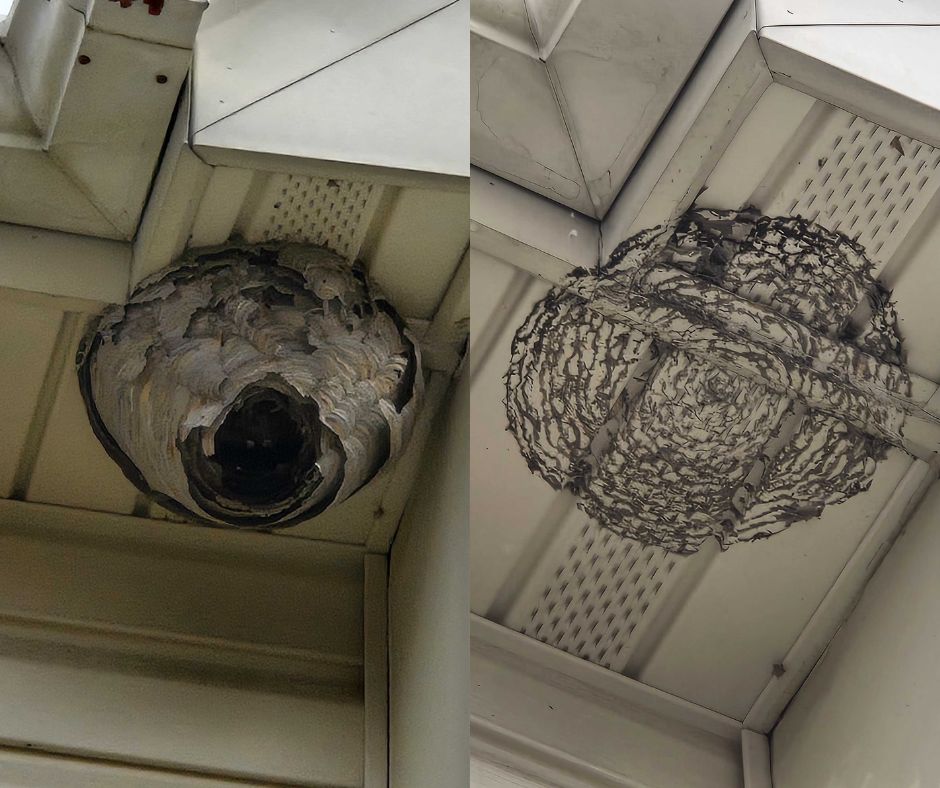
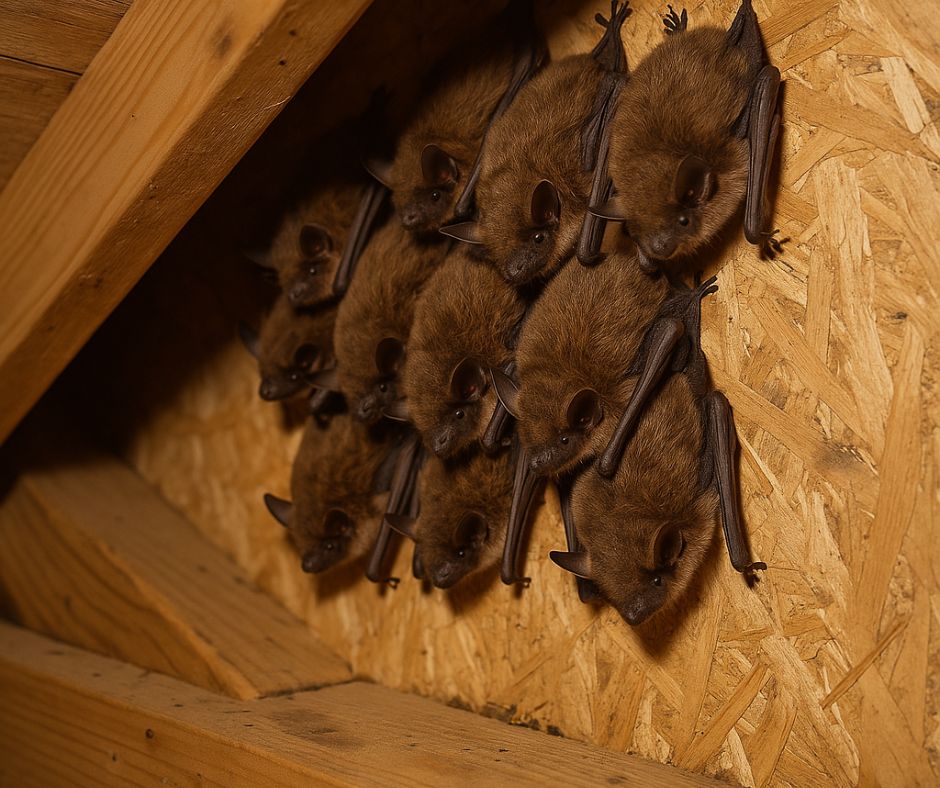 Common Myths About Bats DEBUNKED!
Common Myths About Bats DEBUNKED!
Common Myths About Bats DEBUNKED!
Bats are a very misunderstood species, and due to unfair depictions in storytelling and pop culture, they have garnered a bad rap. However, bats are a very beneficial species that is crucial to the environment! While bats can be dangerous when they get inside your home, they are also federally protected, so it’s important to treat them with care. Westchester Wildlife can help, we offer safe, humane bat removal and exclusion services in the Westchester County area. We utilize the industry-tested Bat-cones and Pro-cones to safely let bats out of your home or commercial property, without allowing them to get back in. Contact our team to get started today at (800) 273-6673!
Myth: All Bats Suck Blood!
False! While vampire bats do exist, they are only a small subspecies that are found in Central and South America. In these countries, vampire bats rarely feed on humans, instead choosing to feed on livestock, birds, or wild animals. None of the bats native to the United States feed on blood. Instead, native bats like the Little Brown Bat and the Hoary Bat feed on insects, fruit, and plant nectar.
Myth: Bats Will Attack Me or Fly Into My Hair!
False! Bats are non-confrontational, and prefer to avoid humans whenever possible. If a bat swoops down close to you, it is most likely trying to catch a mosquito or other insect, and is not trying to hurt you. Bats may bite or scratch, but only when they are cornered/are being handled, which you should NEVER do.
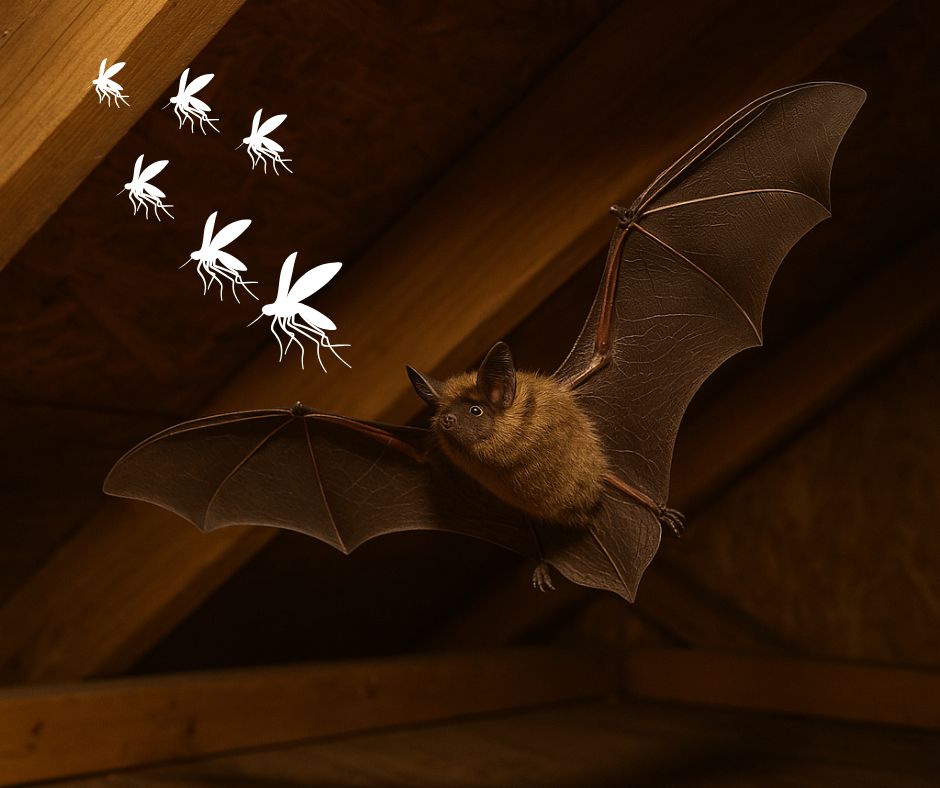
Myth: All Bats Have Rabies!
Nope! Less than 1% of bats test positive for rabies. However, bats are the most commonly reported animal to have rabies, and bats are responsible for most rabies deaths in the United States, so it’s important to treat any bat exposure as a potential rabies exposure. If you see a bat active during the day, a bat found in an unusual space, or a bat that is unable to fly or easily approached, be very cautious and contact animal control immediately as these are often signs of rabid bats. Another reason why bats are able to spread rabies so easily is because they have very small teeth and claws, so their bites and scratches can often go unnoticed.
Myth: Bats are Blind!
Not true! While many people think that bats are totally blind and only rely on echolocation, that could not be farther from the truth! Bats do have very small eyes and sensitive vision that is adapted to see in the dark, as bats are mostly active at nighttime. Their vision allows bats to interact with each other, avoid predators, and navigate across the sky. Echolocation, the process of emitting high-pitched sounds and interpreting echoes, is a mostly supplemental tool used to find insect prey and to navigate.
Myth: Bats Aren’t Beneficial
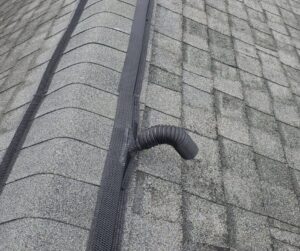 Incorrect! Bats are EXTREMELY beneficial to humans and the environment! Bats are excellent pollinators, crucial for the production of over 500 plants, including several important crops like bananas and mangos. In addition to their excellent pollinating, bats are also excellent pest control agents, able to eat as many as 1200 mosquitoes or mosquito-sized insects in a single hour! Bats are crucial to our ecosystem, but they unfortunately are in danger. Bat populations have been dying off due to encroaching human habitats and the spread of white-nose syndrome. This is why bats are federally protected, and must be handled with care. If you have bats nesting inside your attic, contact the experts at Westchester Wildlife. Our company’s owner and founder Jim Driesacker invented the bat-cone, a humane bat exclusion device that allows bats to leave your attic, but not get back inside. Our team utilizes bat-cones to safely remove bats from your attic without any harm. Get in touch with our team today to get started at (800) 273-6673!
Incorrect! Bats are EXTREMELY beneficial to humans and the environment! Bats are excellent pollinators, crucial for the production of over 500 plants, including several important crops like bananas and mangos. In addition to their excellent pollinating, bats are also excellent pest control agents, able to eat as many as 1200 mosquitoes or mosquito-sized insects in a single hour! Bats are crucial to our ecosystem, but they unfortunately are in danger. Bat populations have been dying off due to encroaching human habitats and the spread of white-nose syndrome. This is why bats are federally protected, and must be handled with care. If you have bats nesting inside your attic, contact the experts at Westchester Wildlife. Our company’s owner and founder Jim Driesacker invented the bat-cone, a humane bat exclusion device that allows bats to leave your attic, but not get back inside. Our team utilizes bat-cones to safely remove bats from your attic without any harm. Get in touch with our team today to get started at (800) 273-6673!
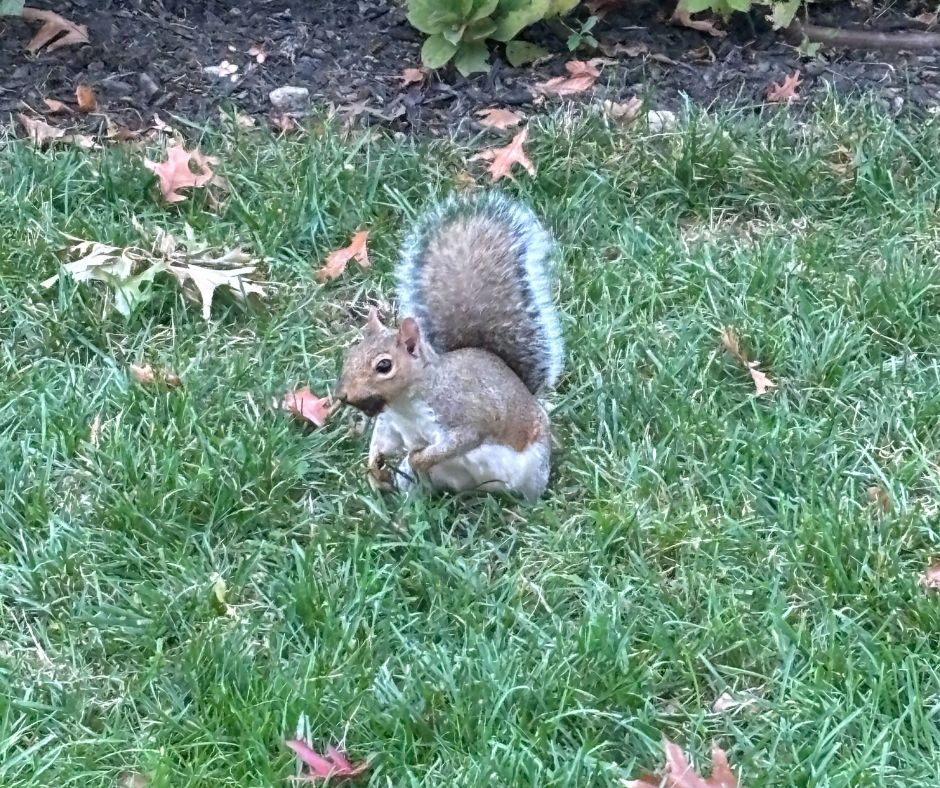 Are Squirrels Dangerous?
Are Squirrels Dangerous?
Are Squirrels Dangerous?
Squirrels scurrying across fences and along tree branches are a very common sight for homeowners in Westchester County. Squirrels can be spotted running across rooftops and getting close to porches and decks. While squirrels may look cute, the damage they do to your home and the diseases they can spread are anything but.
Squirrels can tear out your attic insulation and chew through wires, creating a fire risk. Squirrels can also spread diseases like tularemia, as well as parasites like ticks and fleas. If you need squirrels trapped and removed from your attic in Westchester, contact the experts at Westchester Wildlife today to get started at (800) 273-6673!
Why Squirrels Invade Homes
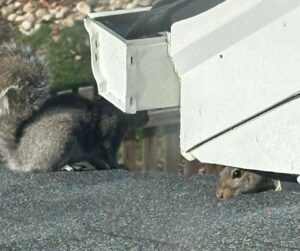 Squirrels are looking for the same thing that all living creatures need to survive: food, water, and shelter. Your attic space provides a perfect place for squirrels to nest, as it is safe, warm, secluded, and protected against predators and the elements. Trees or bird feeders may provide a source of food to hungry squirrels, and your wall voids can provide a spot for squirrels to stash their food for retrieval during the winter months.
Squirrels are looking for the same thing that all living creatures need to survive: food, water, and shelter. Your attic space provides a perfect place for squirrels to nest, as it is safe, warm, secluded, and protected against predators and the elements. Trees or bird feeders may provide a source of food to hungry squirrels, and your wall voids can provide a spot for squirrels to stash their food for retrieval during the winter months.
When getting inside your house, squirrels will exploit any cracks, gaps, or weak spots they can find, usually on damaged soffits, ridge vents, or weakened/missing roof shingles. Squirrels can even enter through your chimney. Once the squirrels have gotten inside, they will begin wreaking havoc on your home.
How Much Damage Can A Squirrel Do To A House?
Squirrels are small, but they have sharp teeth and claws that enable them to do more damage than you might expect.
- Chewing and Gnawing: squirrels have teeth that never stop growing, which means they need to constantly be gnawing on wooden beams, soffits, and rubber wire coverings to file down their teeth and keep the length manageable.
- Electrical hazards: when squirrels chew on the rubber covering surrounding wires, they can expose the bare wiring to the insulation, which can pose a fire hazard.
- Structural damage: over time, squirrels can weaken attic beams by chewing through them, creating structural instability.
- Insulation problems: squirrels will rip out your insulation to make their nests, and they will also soil it with their urine and droppings
Are Squirrels Dangerous to Humans?
Squirrels are rarely aggressive and prefer to stay out of the way of humans, but if they are cornered or trapped, they may lash out with their claws and teeth. That’s why it’s always best to leave squirrel removal to the professionals. Wildlife professionals will have the tools and equipment to safely remove squirrels without harm to either party.
Squirrels can also spread various diseases, including tularemia, leptospirosis, salmonellosis, and more. Squirrels also carry parasites like ticks and fleas, which can spread Lyme disease and Rocky Mountain Spotted Fever.
Signs of a Squirrel Infestation
Recognizing the signs of a squirrel infestation can help you get the situation under control faster. Some things to look out for include:
- Scratching or scampering noises coming from inside the attic, typically during the day as squirrels sleep at night
- Chewed and shredded insulation in the attic, or gnaw marks on wooden beams
- Holes in your soffit, missing shingles, bent roof vents
- Smell of droppings or urine coming from the attic
- Squirrels on your roof
What to Do If You Have A Squirrel Problem
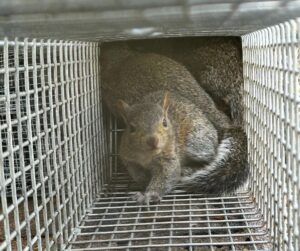 If you have a squirrel problem on your property in Westchester, don’t attempt to remove them yourself. Squirrels are unpredictable wild animals, and can become aggressive if threatened, especially when their babies are nearby. Squirrels are also adept at hiding their babies within attic insulation, and you might accidentally leave one behind when evicting a squirrel family. Wildlife removal professionals have the proper tools, training, and equipment to safely and carefully remove squirrels from your home in Westchester.
If you have a squirrel problem on your property in Westchester, don’t attempt to remove them yourself. Squirrels are unpredictable wild animals, and can become aggressive if threatened, especially when their babies are nearby. Squirrels are also adept at hiding their babies within attic insulation, and you might accidentally leave one behind when evicting a squirrel family. Wildlife removal professionals have the proper tools, training, and equipment to safely and carefully remove squirrels from your home in Westchester.
Animal control typically will not come out to deal with a squirrel infestation in your attic, as they deal with animals on public property like roads and parks, or animals that pose direct threats to people like a rabid raccoon. The best way to solve your squirrel problem is to contact a private wildlife removal service like Westchester Wildlife.
Best Squirrel Removal Service in Westchester
Westchester Wildlife offers the best squirrel removal service in Westchester County. Squirrels are a very destructive nuisance critter that can cause severe damage to your property when they nest inside your attic space. Westchester Wildlife can help, our team will safely remove squirrels, using humane live-traps and exclusion techniques. Our technicians will ensure all baby squirrels are removed with their parents and none are left behind. After the squirrel family is gone, our team can clean up their nesting material and seal off all current and potential entry points, preventing the squirrels from getting back inside in the future. Contact us today to get started with squirrel removal at (800) 273-6673!
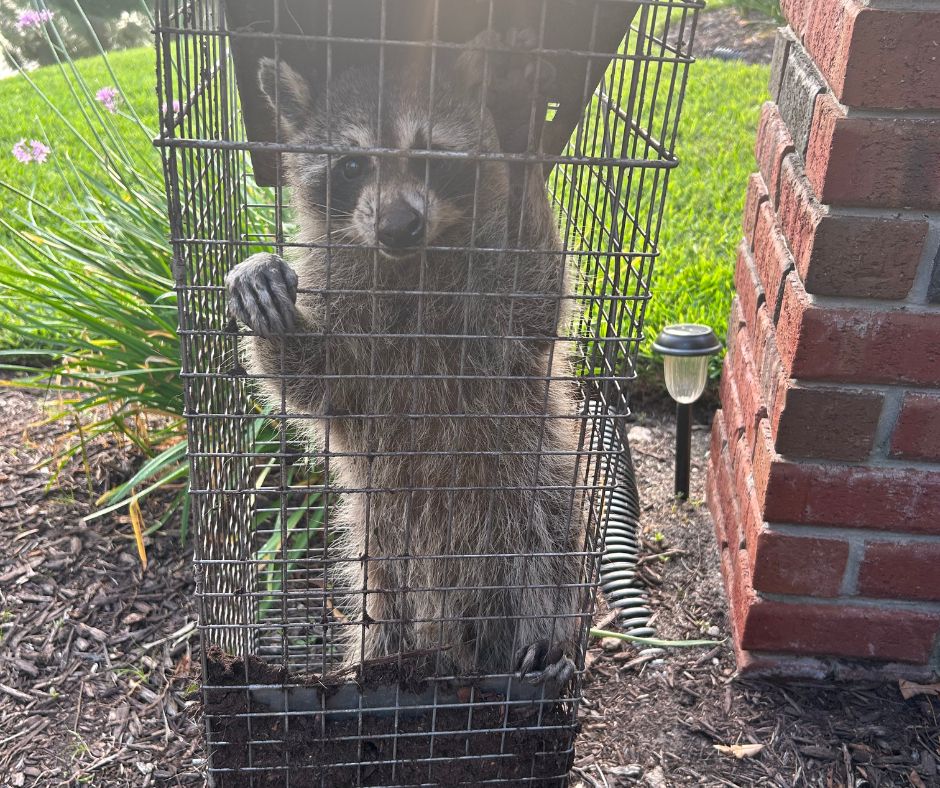 The Benefits of Professional Wildlife Removal Services vs DIY Methods
The Benefits of Professional Wildlife Removal Services vs DIY Methods
The Benefits of Professional Wildlife Removal Services vs DIY Methods
An unfortunate reality of owning a home is that you have to deal with the occasional pest infestation, or even a wildlife problem. Critters like raccoons, squirrels, bats, and more will break their way into your home, often choosing your attic as a nesting spot. In addition to critters in your attic, scavengers like raccoons, opossums and foxes are known to knock over your outdoor trash cans, throwing trash across the lawn. Groundhogs will burrow underneath your home’s foundation, causing it to crack and settle. Moles will dig tunnels in your lawn, ripping up the grass and destabilizing the soil. When dealing with nuisance wildlife concerns, it’s important to act as quickly as possible, as the problem will not go away with time; it will get worse. When dealing with a nuisance wildlife infestation, many homeowners want to go the DIY route initially. However, wildlife removal presents many challenges and dangers, and should always be left to professionals. If you need nuisance wildlife removal services in Westchester County, Putnam County, or Dutchess County, contact the experts at Westchester Wildlife today for a FREE estimate at (800) 273-6673!
The Risks and Limitations of DIY Wildlife Removal
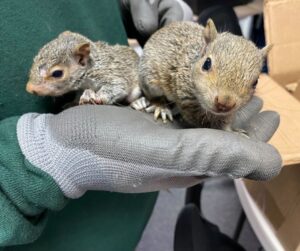 Removing an animal from your property may sound tempting, but it poses several risks that you might not consider. Raccoons are armed with sharp claws and teeth, and are known to lash out and injure people, especially if they are accompanied by their young. Raccoons are adept at hiding their babies deep inside the insulation, and the untrained eye can miss one or two of the babies when evicting a raccoon family. Raccoons are also a common carrier of the rabies virus.
Removing an animal from your property may sound tempting, but it poses several risks that you might not consider. Raccoons are armed with sharp claws and teeth, and are known to lash out and injure people, especially if they are accompanied by their young. Raccoons are adept at hiding their babies deep inside the insulation, and the untrained eye can miss one or two of the babies when evicting a raccoon family. Raccoons are also a common carrier of the rabies virus.
Bats also carry rabies, and even handling a bat can be counted as a potential rabies exposure. Bats are also endangered and under protection from federal law, and mishandling or killing them can incur serious fees. Skunks are not easy to remove, as they will use their signature spray defense, which causes a horrible odor that is very difficult to get rid of. Squirrels and groundhogs can also become aggressive when cornered, and they can spread diseases like tularemia and leptospirosis. Even removing bat guano can pose a risk, as bat guano contains the spores that cause the fungal lung infection histoplasmosis.
In addition to the safety risks, you might run into limitations when attempting to remove wildlife on your own. Store bought traps can be ineffective if not placed correctly, especially with groundhogs. Many “repellents”, from sprays to flashing light devices and noise makers are either ineffective, or only effective for a short time. Wildlife can adapt to lights and sounds easily, as soon as they realize it doesn’t pose an actual threat.
The Advantages of Hiring a Professional Wildlife Removal Service
Hiring a professional wildlife removal service to deal with your wildlife problem offers several advantages over doing it yourself. Professional wildlife technicians are armed with professional equipment and traps, including proper safety equipment. Professional wildlife removal technicians also ensure that all federal and local laws and ordinances are followed during the process, and that all animals involved are treated humanely. Relying on professional services also minimizes the risk of disease transmission, protecting you from rabies, histoplasmosis, and other zoonotic diseases.
When you hire a nuisance wildlife professional, they can provide you with long term solutions that address the underlying problem. This can involve exclusions, seal-outs, repairing leaks, fixing wildlife damage, and more.
Cost Comparison: DIY vs. Professional Services
Many people jump at the chance to do DIY wildlife removal because it costs less in the short term, but did you know that professional wildlife removal services can actually save you much MORE money in the long run?
DIY efforts may have cheaper upfront costs, but because DIY wildlife removal is often ineffective, you might be stuck paying that cost over and over again. Critters like raccoons are armed with seriously dangerous claws and teeth, and if your attempt to remove a raccoon goes south, you might have to pay for medical bills. If you remove the wildlife from your home or yard improperly, they could come back and create even more structural damage, costing you more money for repairs. Professional wildlife removal services ensure that your wildlife problem is safely dealt with, and your property is safeguarded against future infestations, making it much cheaper in the long run.
When to Call a Professional
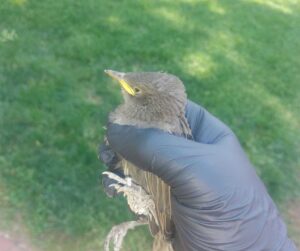 Knowing which situations require a wildlife removal professional can save you time and energy. Wildlife professionals are most helpful for dealing with animals that are living on your property or spending lots of time near your property. Raccoons, squirrels and bats living in your attic, a venomous snake in your garden or crawl space, moles tearing up your yard, a skunk building a den under your porch, all of these situations would require a wildlife professional. However, if a raccoon is just simply passing through your yard, or if a squirrel is running across your fence, you can wait it out and see if they stick around before contacting a wildlife removal company. Most of the time, without any food sources or easy shelters, critters in your yard will just move on.
Knowing which situations require a wildlife removal professional can save you time and energy. Wildlife professionals are most helpful for dealing with animals that are living on your property or spending lots of time near your property. Raccoons, squirrels and bats living in your attic, a venomous snake in your garden or crawl space, moles tearing up your yard, a skunk building a den under your porch, all of these situations would require a wildlife professional. However, if a raccoon is just simply passing through your yard, or if a squirrel is running across your fence, you can wait it out and see if they stick around before contacting a wildlife removal company. Most of the time, without any food sources or easy shelters, critters in your yard will just move on.
Wildlife removal professionals also do not deal with domestic animals like dogs and cats, or animals that are on public property like roads or parks, as both of these situations are problems for animal control. However, if an animal dies on your property, then dead animal removal does fall under wildlife removal services.
If you need professional wildlife removal in Westchester County, Putnam County, or Dutchess County, contact the experts at Westchester Wildlife. Our team of highly trained wildlife technicians are armed with the tools, training, and experience to safely and humanely remove nuisance critters from your property. Get in touch with our office today to get scheduled at (800) 273-6673!
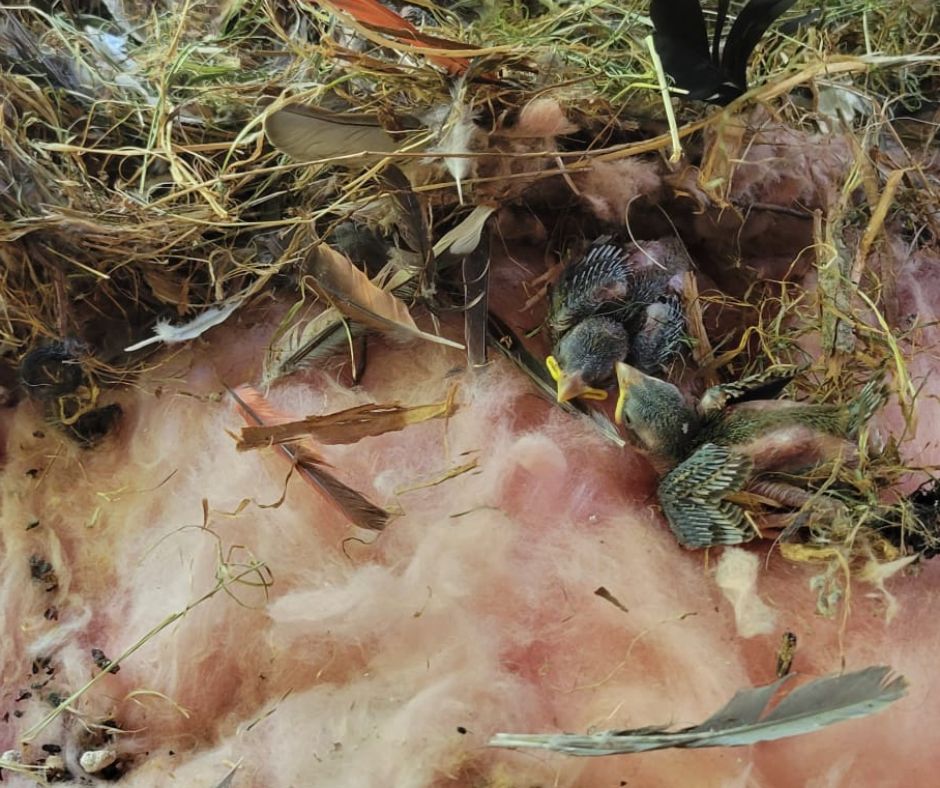 When To And When NOT To Call A Professional Wildlife Removal Company
When To And When NOT To Call A Professional Wildlife Removal Company
When To And When NOT To Call A Professional Wildlife Removal Company
When faced with a nuisance wildlife situation, you might find yourself wondering who you can call to help you out. We commonly receive calls from people across the Westchester County area that are wondering who they need to get in contact with to deal with the distressing situation at hand. Animal control and wildlife removal provide different services, as animal control won’t deal with animals on private property, and wildlife removal companies won’t deal with domestic animals. If you have a nuisance wildlife situation inside your attic, crawl space, or anywhere else on your property, contact the experts at Westchester Wildlife! Our team has the tools and the training to safely and humanely remove raccoons, squirrels, bats, chipmunks, groundhogs, and more!
Domestic Animals and Feral Cats
Professional wildlife companies do not deal with domestic animals. Domestic animals include cats, dogs, and all other animals that are kept as pets and not native to the area. If you have a colony of feral cats on your property, these would actually be under the jurisdiction of animal control. Similarly, if you have a lost dog, or if you have seen a dog running free through your neighborhood, that is also a situation for animal control. Westchester Wildlife does NOT deal with dogs, cats, or any other domestic animal.
Wildlife Inside Your Attic
When you have wildlife inside your attic space, this is a perfect situation for a wildlife removal company. Raccoons, squirrels, opossums, bats, and rodents will break into your attic and nest inside your insulation, often ripping it up and soiling it.Unfortunately, when nuisance wildlife have taken up residence on your private property, they are no longer within the jurisdiction of animal control. DIY removal is not recommended, because raccoons and bats can spread the rabies virus through bites and scratches, and all of these animals can become aggressive when handled or cornered. If you have a nuisance critter inside your attic, your best bet is to contact a licensed wildlife removal company.
If you have birds like pigeons, sparrows, or starlings nesting inside your attic, or inside your home’s exterior vents like a dryer vent, removing these birds and their nesting material is under the jurisdiction of a nuisance wildlife company.
Rabid Animals/Animals on Public Property
If there is a rabid, aggressive animal, domestic or wildlife, that is posing a direct threat to people, then this is a case for animal control. If there’s a raccoon on public property like in the road or in a public park, this falls under animal control. The government is responsible for removing dead animals from the road, and from other public property. However, if a deer is hit by a car, wanders into your yard and then dies, it becomes your responsibility and falls under the jurisdiction of a wildlife removal company. Wildlife removal companies handle dead animal removal for nuisance critters like raccoons, squirrels, deer, and more.
Bees and Wasps | Mice and Rats
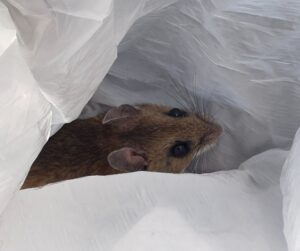 Bees and wasps are stinging insects that can become aggressive if they perceive you as a threat. This is worsened by the fact that bees and wasps often build their nests on porches, decks, and inside attic spaces, increasing the likelihood of a conflict with you. Bees and wasps are typically covered by pest control companies, however, Westchester Wildlife also offers bee and wasp nest removal services in the Westchester County area.
Bees and wasps are stinging insects that can become aggressive if they perceive you as a threat. This is worsened by the fact that bees and wasps often build their nests on porches, decks, and inside attic spaces, increasing the likelihood of a conflict with you. Bees and wasps are typically covered by pest control companies, however, Westchester Wildlife also offers bee and wasp nest removal services in the Westchester County area.
Similarly, issues with rodents like mice and rats tend to fall under the jurisdiction of both pest control companies and wildlife removal companies, as they are both pests and nuisance wildlife. If you have an issue with a rat or mice infestation in Westchester County, Putnam County, or Dutchess County, Westchester Wildlife can help! We offer the best rodent control and prevention services in the area.
Termites, Ants, and Other Pests
When it comes to insect pests like termites, ants, roaches, silverfish, and more, this falls squarely under the jurisdiction of a licensed pest control professional. While the Westchester Wildlife team can help with rodents and stinging insects, we do NOT deal with termites, ants, and other insect pests.
Animals In Your Yard/Under Your Deck
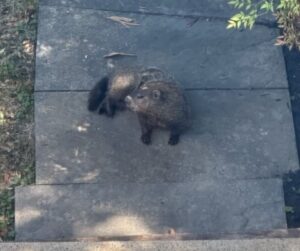 Attics aren’t the only area on your property that nuisance wildlife will hang out in. Groundhogs are known to dig extensive underground burrows on your property, which can destabilize the soil and lead to your foundation cracking and settling. Groundhogs are also infamous for decimating gardens, feeding on the vegetable crops within. Skunks and foxes are known to dig out dens underneath porches, decks, and sheds. Moles and voles will also dig unsightly tunnels in your garden, with moles leaving behind kicked-up molehills of dirt, and voles leaving behind shallow trenches. You might also deal with opossums and rodents inside your crawl space, or raccoons inside your garage. When you have non-domestic wild animals causing trouble in areas of your property besides your attic, this is another situation where you would call a nuisance wildlife company like Westchester Wildlife.
Attics aren’t the only area on your property that nuisance wildlife will hang out in. Groundhogs are known to dig extensive underground burrows on your property, which can destabilize the soil and lead to your foundation cracking and settling. Groundhogs are also infamous for decimating gardens, feeding on the vegetable crops within. Skunks and foxes are known to dig out dens underneath porches, decks, and sheds. Moles and voles will also dig unsightly tunnels in your garden, with moles leaving behind kicked-up molehills of dirt, and voles leaving behind shallow trenches. You might also deal with opossums and rodents inside your crawl space, or raccoons inside your garage. When you have non-domestic wild animals causing trouble in areas of your property besides your attic, this is another situation where you would call a nuisance wildlife company like Westchester Wildlife.
Best Wildlife Removal Company in Westchester County
Whenever you need an issue with a nuisance wildlife problem resolved, whether it be a bat colony in your attic, a raccoon in your garage, a dead deer in your yard, or a groundhog digging up your garden, trust the wildlife removal experts at Westchester Wildlife. Our team of licensed wildlife removal experts will safely, carefully, and humanely help resolve your wildlife issue to protect both you and the animal. We service Westchester County, Putnam County, Dutchess County, Fairfield County, and more! Contact our team to get started today with a FREE estimate at (800) 273-6673!
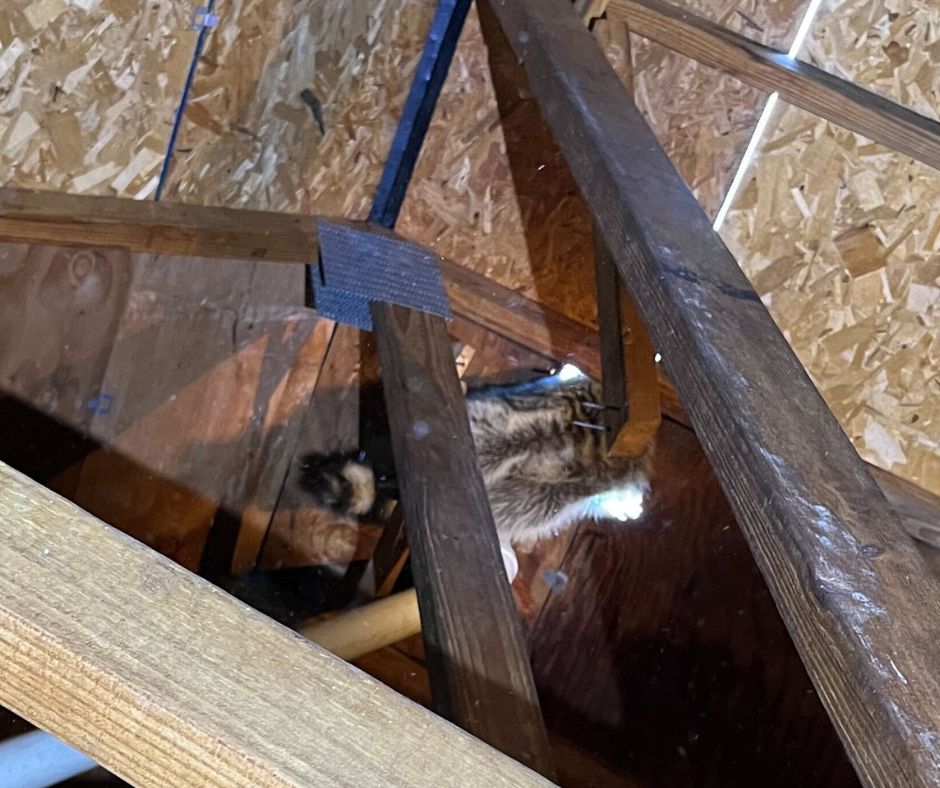 Do Raccoons Hibernate? Understanding Their Winter Behavior and How They Survive the Cold
Do Raccoons Hibernate? Understanding Their Winter Behavior and How They Survive the Cold
Do Raccoons Hibernate? Understanding Their Winter Behavior and How They Survive the Cold
Raccoons do not fully hibernate like bears and groundhogs do. If faced with severe temperatures and a lack of food, raccoons can enter a state of torpor, or decreased activity, to conserve their energy. Raccoons will only enter torpor when necessary, and they prefer to seek out warm shelter and abundant sources of food to survive the winter. Unfortunately, this often means that they will break their way into your attic in order to build nests inside, often ripping up your attic insulation and tearing through any ductwork inside the attic in the process. If you need raccoon trapping and removal in Westchester County, Putnam County, Dutchess County, Fairfield County, or Litchfield County, contact the wildlife removal experts at Westchester Wildlife today at (800) 273-6673 for a FREE estimate!
How Raccoons Survive the Cold
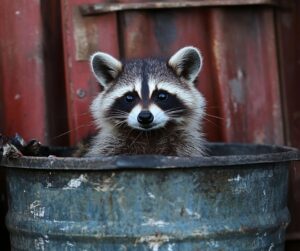 Raccoons do not hibernate during the winter, so they have several other body processes to help them survive the freezing temperatures and harsh conditions of winter. Raccoons, when faced with no other options, will enter a state of lowered activity called torpor, which is distinctly different from hibernation.
Raccoons do not hibernate during the winter, so they have several other body processes to help them survive the freezing temperatures and harsh conditions of winter. Raccoons, when faced with no other options, will enter a state of lowered activity called torpor, which is distinctly different from hibernation.
Torpor is involuntary and happens when faced with environmental challenges, while hibernation is a process that animals prepare for. Additionally, torpor doesn’t last for a long time, typically only a few hours to a few days, and raccoons will wake up to forage during this time. Hibernation on the other hand, lasts for months, and animals in hibernation do not wake up to forage. Raccoons often rely on stored body fat to survive the winter, and may engage in less activity in order to conserve their energy. Raccoons also have a thick, grey coat of fur that provides them with insulation against freezing temperatures and snow. However, raccoons still need to find sources of shelter during the winter, which might lead them to your home.
Where Raccoons Seek Shelter in Winter
During the winter months, raccoons will seek shelter to escape the freezing temperatures and precipitation. Sometimes this can be a natural shelter, like the inside of a hollow tree or log. Raccoons will also seek shelter inside rock crevices, and they will oftentimes take over burrows that were originally dug out by groundhogs, skunks and foxes but have since been abandoned. However, nowhere is more perfect for a raccoon den than your home.
What Drives Raccoons Indoors During the Winter
During the winter, food sources are much more scarce for raccoons. Plants are dead and insects are underground, so the pickings are slim for a hungry raccoon. This often drives them into urban and suburban neighborhoods, as our homes and businesses provide them with plenty of food. Unsealed trash cans, full of food scraps, provide a perfect food source for a hungry raccoon, as do compost piles. If you leave pet food outside, this provides an easy meal for a raccoon, as do bird feeders.
Raccoons will build their nests underneath your deck/porch, inside a shed or crawl space, or especially inside your attic, for the warmth, safety, and seclusion these places provide. Your attic provides a perfect nesting spot for a raccoon seeking to escape the cold, as it offers protection against predators and the elements. However, raccoons aren’t a house guest you want to willingly shelter, as these mischievous critters can tear through HVAC ducts, destroy your attic insulation, and spread harmful diseases and bacteria.
Signs of a Winter Raccoon Infestation
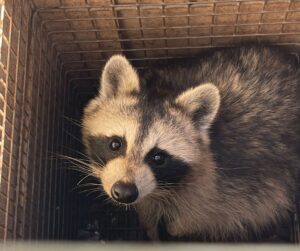 Raccoons are one of the most destructive nuisance wildlife in the Westchester area. Raccoons will exploit the tiniest cracks in your soffit, gable vents, ridge vents, or roof shingles. When a raccoon is nesting inside your attic, you might see damaged soffits, bent or destroyed vents, and missing shingles, signifying where the raccoons are entering and exiting from. Once inside, these critters will start ripping up and shredding your attic insulation, tearing through HVAC ducts, and scratching/gnawing on wooden beams and wires. Raccoons are mostly active at night, so if you are hearing scratching or loud shuffling sounds coming from your attic space, this is a sign that you have raccoons spending the winter in your home.
Raccoons are one of the most destructive nuisance wildlife in the Westchester area. Raccoons will exploit the tiniest cracks in your soffit, gable vents, ridge vents, or roof shingles. When a raccoon is nesting inside your attic, you might see damaged soffits, bent or destroyed vents, and missing shingles, signifying where the raccoons are entering and exiting from. Once inside, these critters will start ripping up and shredding your attic insulation, tearing through HVAC ducts, and scratching/gnawing on wooden beams and wires. Raccoons are mostly active at night, so if you are hearing scratching or loud shuffling sounds coming from your attic space, this is a sign that you have raccoons spending the winter in your home.
Raccoons dig latrines inside your attic insulation to deposit their waste, so a foul smell coming from the attic can signify a problem. This can get even worse if the waste accumulates in such large quantities that it begins to seep through the floor.
If you come outside and see your trash cans knocked over with trash strewn about your yard, or pet food missing from your dog’s bowl despite him being inside all night, you might have a raccoon feasting on your food scraps. It’s important to deal with a raccoon invasion as soon as possible, as these nuisance animals can spread harmful diseases, bacteria, and parasites, like rabies, raccoon roundworm, tularemia, leptospirosis, and more.
How To Prevent Raccoons from Invading Your Home This Winter
There are several easy ways to prevent raccoons from setting up shop in your home this winter:
- Secure all trash cans with a tightly-fitting lid, and remove all outdoor food sources
- Trim tree branches near your home to reduce easy access to the roof for raccoons.
- Contact a licensed wildlife removal company like Westchester Wildlife to locate, seal and fortify all potential entry points on your roof
- Contact Westchester Wildlife to install chimney caps and roof vent guards to keep raccoons out
How Do I Get Rid of Mice in Westchester?
Mice are drawn to food, clutter, water leaks and insulation inside the home, and they can contaminate your food supply, create fire hazards with their gnawing habits and lower the effectiveness of your insulation. Westchester Wildlife can help. We offer effective mice control solutions in Westchester County, NY as well as Putnam County, Dutchess County, and Fairfield County, CT. We will use a combination of mice control techniques including snap traps, bait stations, and exclusion work to eliminate your current mice problem and keep any more from popping up. Contact us today at 800-273-6673!
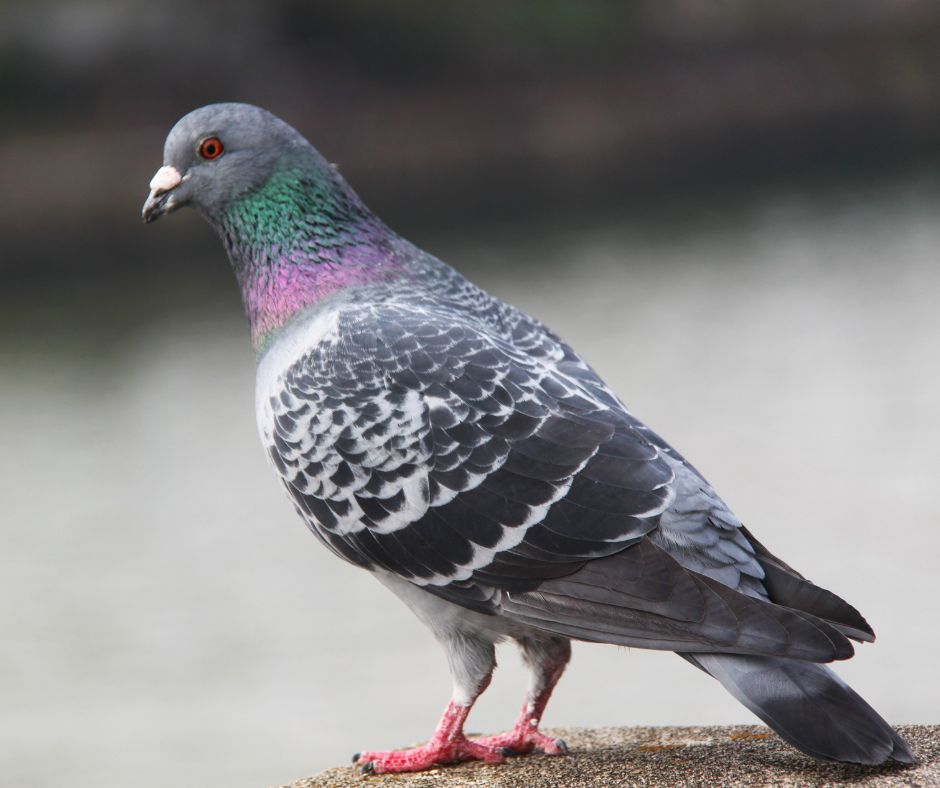 How To Deal With Pigeon Problems in the Winter
How To Deal With Pigeon Problems in the Winter
How To Deal With Pigeon Problems in the Winter
When the freezing temperatures of winter arrive in the Westchester County area, wildlife like groundhogs and snakes will become less active, going into hibernation or torpor to survive the winter. However, several other species of nuisance wildlife are well-adapted to the cold, and will continue searching for sources of food and places to shelter through the winter months. Pigeons are especially well-adapted to surviving the winter, and these nuisance birds, most having lost a natural fear of humans, have no problem seeking food and shelter inside buildings. When pigeons nest inside your property, they can create unsanitary messes, spread parasites, and even damage structures with their acidic droppings. Don’t worry, Westchester Wildlife can help. Our team offers safe, humane pigeon deterrent and removal services in the Westchester, NY area. Contact our team to get started today with a FREE estimate at (800) 273-6673!
Do Pigeons Migrate For The Winter?
When you think of birds in the winter, you might picture a flock of geese flying south in a “v” formation to wait out the colder temperatures. While plenty of birds in New York like sparrows, thrushes and ducks migrate south, the crafty pigeon is more than well-equipped to survive New York’s wintry weather. Pigeons have a thick, downy coat of fluffy feathers that can allow them to survive in temperatures as low as -40 degrees fahrenheit! Pigeons are also well-adapted to eating bread crumbs and other human food that we leave outside year-round, so they don’t face a shortage of food in the winter. Pigeons tend to not have the usual fear of humans that other birds do, so they might become even more bold in the winter, getting closer to our homes and businesses as they search for food scraps and warm places to build their nests.
Pigeon in Attic Damage
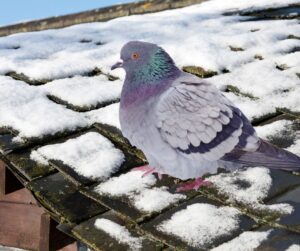 During the winter, pigeons that are well-adapted to urban and suburban areas will be searching for safe, warm places to begin building their nests. Unfortunately, your home’s attic provides the perfect harborage for these avian pests. Pigeons will nest inside your attic, your dryer vents, your gutters, and any other little pocket they can find in your home. Pigeon nests can be dangerous, as the dry twigs, dead leaves, dead grass and straw can lead to a fire hazard, especially if they are nesting inside your dryer vent. If their nests are inside your attic space, these birds can damage your shingles and your siding as they enter and exit the attic. Pigeons might also rip out your attic insulation to add to their nests, which can decrease the insulation’s ability to resist heat. However, the most significant damage caused by pigeons nesting in your home is through their corrosive droppings. Pigeon droppings are known to contain acidic uric acid, which can eat away at materials like wood, metal, shingles, and paint. Not only can this corrode the structures in your home, it can also lead to unsightly staining.
During the winter, pigeons that are well-adapted to urban and suburban areas will be searching for safe, warm places to begin building their nests. Unfortunately, your home’s attic provides the perfect harborage for these avian pests. Pigeons will nest inside your attic, your dryer vents, your gutters, and any other little pocket they can find in your home. Pigeon nests can be dangerous, as the dry twigs, dead leaves, dead grass and straw can lead to a fire hazard, especially if they are nesting inside your dryer vent. If their nests are inside your attic space, these birds can damage your shingles and your siding as they enter and exit the attic. Pigeons might also rip out your attic insulation to add to their nests, which can decrease the insulation’s ability to resist heat. However, the most significant damage caused by pigeons nesting in your home is through their corrosive droppings. Pigeon droppings are known to contain acidic uric acid, which can eat away at materials like wood, metal, shingles, and paint. Not only can this corrode the structures in your home, it can also lead to unsightly staining.
Diseases Spread by Pigeons
Pigeon droppings often contain the spores that cause the fungal lung infection histoplasmosis. When you move or disturb pigeon droppings, the spores get kicked up into the air, and can infect you when you breathe these spores in. Additionally, pigeon droppings can also spread other illnesses like the bacterial disease psittacosis, the fungal disease cryptococcosis, and foodborne illnesses like E. coli and salmonella. Additionally, pigeons can carry bat bugs, a small insect pest that are very similar to bed bugs. Pigeons can also spread bird mites into your home. Pigeons pose a significant health hazard, and the more pigeons that are roosting in your home, the more significant the health threat is. It’s important to protect yourself by having nuisance pigeons removed or deterred as soon as possible.
Humane Pigeon Removal Services
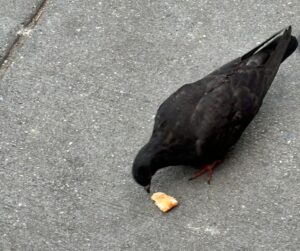 Pigeons can pose a risk to your home through their flammable nests and their corrosive droppings, and they can also pose a health hazard to you and your family through the various diseases and parasites they carry and spread. If you are hearing pigeon coos and flapping noises coming from your attic, or if you are seeing pigeon droppings and feathers around your property, it’s best to contact a licensed wildlife removal professional like Westchester Wildlife for pigeon removal services immediately. Our team of wildlife experts will carefully inspect your home for signs of pigeons, locating all the entry points and nesting. We will safely and humanely trap and remove all the pigeons on your property, and remediate any damage caused by these pest birds. Additionally, we also offer dead bird removal if you have a dead pigeon inside your home or yard. If you need pigeon removal services in the Westchester area, contact our team today to get on the schedule at (800) 273-6673.
Pigeons can pose a risk to your home through their flammable nests and their corrosive droppings, and they can also pose a health hazard to you and your family through the various diseases and parasites they carry and spread. If you are hearing pigeon coos and flapping noises coming from your attic, or if you are seeing pigeon droppings and feathers around your property, it’s best to contact a licensed wildlife removal professional like Westchester Wildlife for pigeon removal services immediately. Our team of wildlife experts will carefully inspect your home for signs of pigeons, locating all the entry points and nesting. We will safely and humanely trap and remove all the pigeons on your property, and remediate any damage caused by these pest birds. Additionally, we also offer dead bird removal if you have a dead pigeon inside your home or yard. If you need pigeon removal services in the Westchester area, contact our team today to get on the schedule at (800) 273-6673.
Pigeon Deterrents
In addition to pigeon removal services, pigeon deterrents are also effective at keeping these pesky birds away from your property. Bird spikes can be placed around target areas like roofs to keep pigeons from landing on your home, and bird netting can prevent them from getting inside your yard. Getting rid of bird feeders and bird baths can help deter pigeons, and so can ensuring that you have a tight, sealed lid on your trash cans. Westchester Wildlife offers bird exclusion services to keep pigeons out of your attic. We will locate all potential entry points for pigeons, and then seal them off and fortify them, preventing pigeons, other birds, and even other wildlife like raccoons and squirrels from getting in.
Best Pigeon Removal in Westchester, NY
Pigeons may just seem like a nuisance you see begging for bread crumbs, but when a group of pigeons decides to settle down on your property, they can become a serious problem. Pigeon droppings can corrode wood and metal, as well as spread harmful diseases like histoplasmosis. Pigeons themselves can carry parasites like bat bugs and bird mites, and they can rip up your insulation to add to their nests, which are often made out of flammable materials like straw and dead leaves. Don’t worry, Westchester Wildlife can help. Our team of wildlife experts can safely and humanely remove and exclude pigeons from your property in Westchester County. Contact our team to get started today with a FREE estimate at (800) 273-6673.
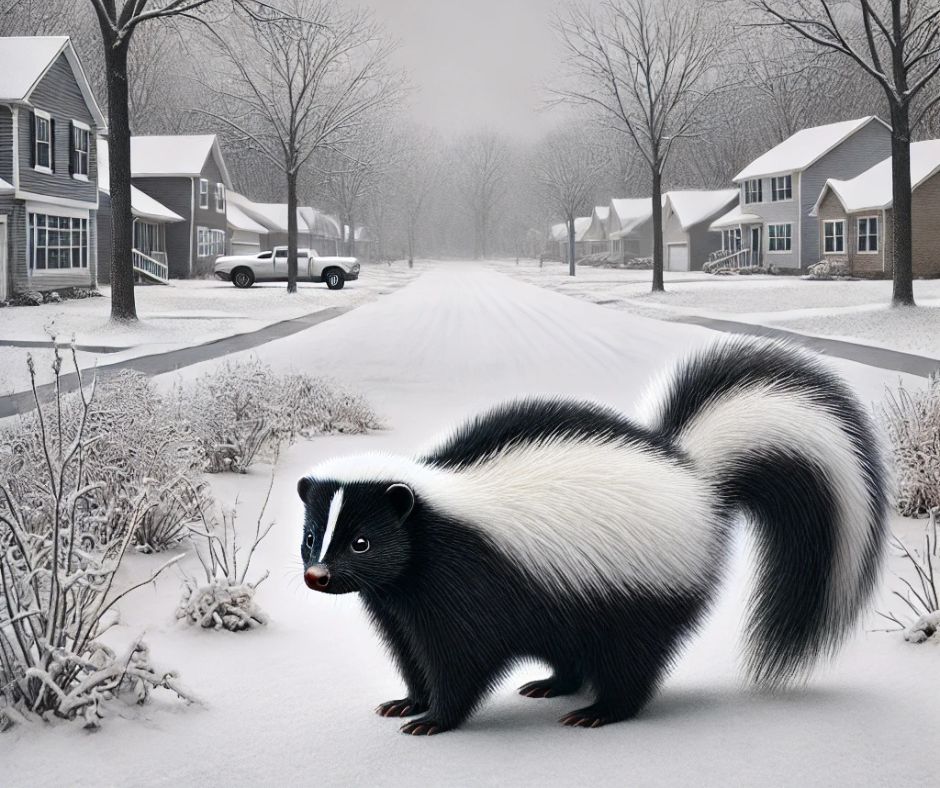 Where Do Wildlife Go In The Winter?
Where Do Wildlife Go In The Winter?
Where Do Wildlife Go In The Winter?
You might associate the presence of nuisance wildlife like squirrels, raccoons and skunks with the hot temperatures and longer days of summer, but where do they go during the colder, snowy months? While some critters like snakes and groundhogs go into torpor and hibernation, squirrels, raccoons, rodents and skunks will stay active throughout the winter, trying to get inside your attic or crawl space, or ripping up your yard in search of food. If you are dealing with nuisance wildlife causing problems on your property in Westchester, then contact the experts at Westchester Wildlife. We offer safe, humane, wildlife trapping and removal services in the Westchester, Dutchess, and Putnam County areas.
Squirrels
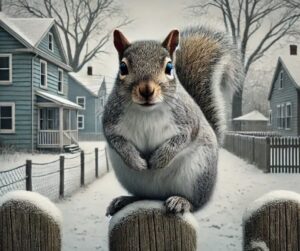 Squirrels stay active throughout the entire fall, scavenging for nuts and seeds they can store inside piles of food called “caches” that they hide around their territory. Squirrels can hide their food inside hollow tree cavities, inside holes in the ground, or sometimes even inside attic spaces or wall voids. During the winter, squirrels will begin retrieving food from their caches, while also searching for warm, safe places to spend the winter. Unfortunately, this often means squirrels will set up shop in your attic. Squirrels inside the attic will rip up your insulation to make their nests, often soiling it in the process with urine and droppings.
Squirrels stay active throughout the entire fall, scavenging for nuts and seeds they can store inside piles of food called “caches” that they hide around their territory. Squirrels can hide their food inside hollow tree cavities, inside holes in the ground, or sometimes even inside attic spaces or wall voids. During the winter, squirrels will begin retrieving food from their caches, while also searching for warm, safe places to spend the winter. Unfortunately, this often means squirrels will set up shop in your attic. Squirrels inside the attic will rip up your insulation to make their nests, often soiling it in the process with urine and droppings.
Raccoons
Similar to squirrels, raccoons will gorge themselves on food during autumn, building up fat reserves to protect them during the winter. However, raccoons do not build up food caches and instead must continue searching for food throughout the winter. This won’t be too hard for the crafty raccoon, as these scavengers eat pretty much anything. Raccoons will become more desperate for food during the winter, and more willing to invade your property to dig through your trash can, raid your bird feeder, or eat out of pet food bowls that have been left outside. Raccoons do not hibernate, but they may den together to conserve body heat and enter a state of lowered activity called torpor when the temperatures go below 20 degrees. Raccoons will also seek out shelter within your home, getting inside your attic where they will tear through insulation and HVAC ducts. Raccoons also dig latrines inside insulation, where the waste can build up in such large quantities that it can begin to seep through the ceiling.
Mice and Rats
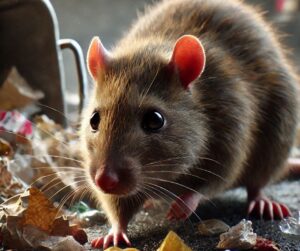 Mice and rats have evolved to live alongside humans, and the warmth and food associated with our homes often draws these rodents inside when the temperatures drop. Mice might huddle in their outdoor nests and slow down their activity when the weather begins to get really frigid. Rats cannot survive without people, and will die in the winter if they can’t find shelter or food. Rodent activity will ramp up as the temperatures plummet. You might see greasy marks alongside the baseboards of your home that are left by rats brushing their fur up against it. Rats and mice need to gnaw to keep the length of their ever-growing teeth down, so they will chew holes in cabinet doors, wooden support beams, and the rubber covering around wires, which can expose the bare wiring and pose a fire risk. Mice will also tunnel through your insulation, which can affect its ability to resist heat. One of the main reasons why rodents are attracted to your home in the winter is because your home is often full of food. Whether it be spills and crumbs in the kitchen or dry, prepackaged food in the pantry, your home provides a banquet for hungry rodents in the winter. You might spot chewed holes in paper, soft plastic, or cardboard food packaging. Cleaning up all spills and crumbs immediately and keeping your prepackaged food in sturdy, hard plastic containers can help keep rodents out of your food supply.
Mice and rats have evolved to live alongside humans, and the warmth and food associated with our homes often draws these rodents inside when the temperatures drop. Mice might huddle in their outdoor nests and slow down their activity when the weather begins to get really frigid. Rats cannot survive without people, and will die in the winter if they can’t find shelter or food. Rodent activity will ramp up as the temperatures plummet. You might see greasy marks alongside the baseboards of your home that are left by rats brushing their fur up against it. Rats and mice need to gnaw to keep the length of their ever-growing teeth down, so they will chew holes in cabinet doors, wooden support beams, and the rubber covering around wires, which can expose the bare wiring and pose a fire risk. Mice will also tunnel through your insulation, which can affect its ability to resist heat. One of the main reasons why rodents are attracted to your home in the winter is because your home is often full of food. Whether it be spills and crumbs in the kitchen or dry, prepackaged food in the pantry, your home provides a banquet for hungry rodents in the winter. You might spot chewed holes in paper, soft plastic, or cardboard food packaging. Cleaning up all spills and crumbs immediately and keeping your prepackaged food in sturdy, hard plastic containers can help keep rodents out of your food supply.
Snakes
Snakes are cold-blooded and are less adapted to staying active during the winter. Snakes often brumate, or enter a period of lowered activity, during the winter. Snakes often brumate together in burrows, groundhog tunnels, fox holes, leaf litter, or even inside tree stumps or dead logs. While snakes generally stay away from homes during winter, they might set up shop inside your crawl space, especially if you have a steady population of mice and rats for them to eat.
Groundhogs and Skunks
Groundhogs actually DO hibernate, staying asleep in their underground tunnels from October to late February. When hibernating, a groundhog’s heartbeat slows to 4-10 beats per minute, and their breathing rate slows to one breath every six months. Groundhogs won’t be digging up your yard during the winter, but you might have to deal with another digging critter.
Skunks are scavengers that continue searching for food throughout the winter. During winter, as food sources become more scarce, skunks will be drawn to your property, searching for food within your trash cans. Skunks will also rip up your lawn to find beetle larvae known as grubs to eat. If your property provides enough food sources, skunks might dig out dens underneath your deck or porch, which can increase the likelihood of a spraying incident, especially because skunks spray to mark their territory.
Wildlife Trapping and Removal Near Me
If you are dealing with raccoons, squirrels, mice, rats, snakes, groundhogs or skunks on your property in Westchester County, contact the experts at Westchester Wildlife. Our team can protect your home from these pests and nuisance wildlife this winter. Once these critters have been removed from your property, we can provide you with exclusions and seal-outs to prevent them from returning. Contact our team to get started today with a FREE estimate at (914) 760-5713!
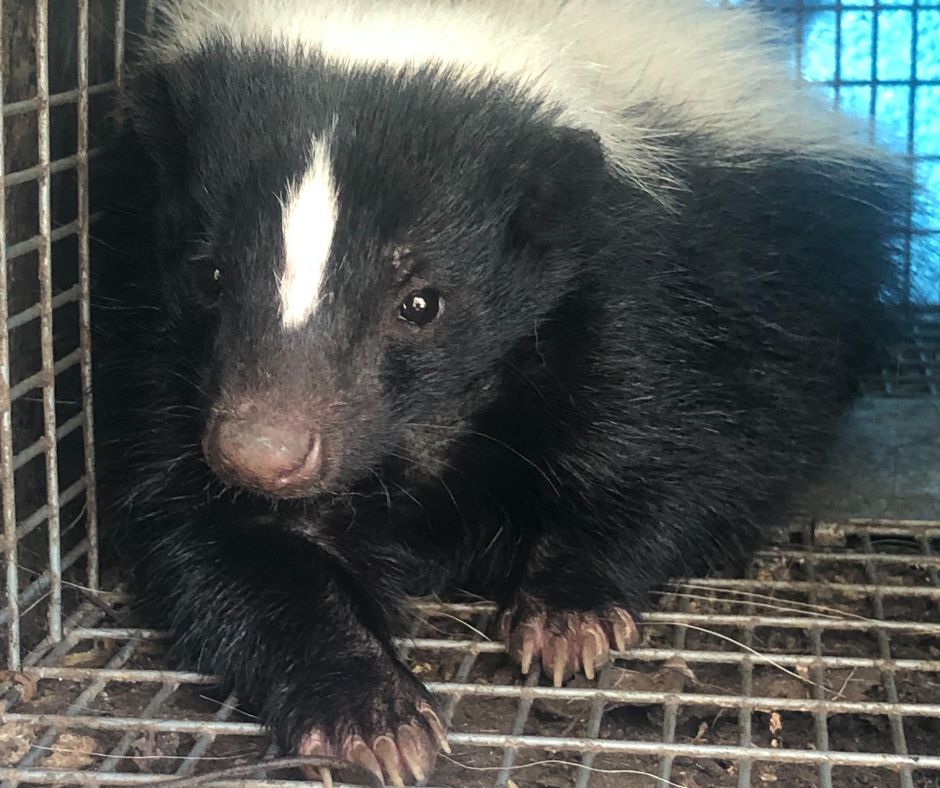 Dangers of a Skunk Problem
Dangers of a Skunk Problem
Dangers of a Skunk Problem
Skunks are the small striped black and white critters that are known for the extremely foul-smelling spray that they will douse threats and potential predators in. The smell of skunk sprays is very difficult to get rid of, especially if a skunk sprays your curious dog. However, this isn’t the only damage that skunks can do. Skunks will also knock over trash cans and raid left out pet food bowls, and they are also known to rip up your grass to find grubs to eat. Skunks will also dig out dens underneath sheds, porches, decks, and inside crawl spaces, spraying around these areas to mark their territory. Don’t worry, Westchester Wildlife can help. In addition to humane skunk trapping and removal services, we also offer wildlife barriers and exclusions to keep these critters off your Westchester property in the future.
Skunk Feeding Habits
Skunks are omnivorous scavengers, eating whatever edible thing they come across. Skunks will prey on mice, birds, bird eggs, voles, moles, and insects like grasshoppers, wasps, bees, crickets, beetles, and especially beetle larvae, also known as grubs. Because grubs are found deep within soil, skunks will rip up your lawn to find these easy meals. Skunks can also feed on your garden crops and any fruits, nuts, or seeds growing in your garden. Skunks are also excellent scavengers, and will happily knock over garbage cans for food, or raid your pet food bowls. Never feed skunks intentionally, as this will make the skunks lose their natural fear of humans, which can result in large congregations of skunks on your property, waiting for the next free meal.
Skunk Sprays
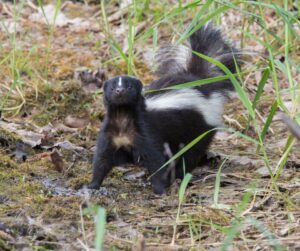 The biggest risk associated with skunks is the extremely foul-smelling spray they will unleash on whatever is posing a direct threat to them. Thankfully, skunks are not an aggressive animal, and will prefer to run away from a fight. Even if a skunk does spray, it gives plenty of warning signs. Skunks about to spray will adopt a wide stance, raise their tail in the air, and aggressively stomp their feet, so if you see a skunk displaying these behaviors, remove yourself from the situation immediately. Skunk sprays can be a major irritant, affecting the eyes, nose, and respiratory system. The odor is unbearable and can cause nausea, and it is very difficult to get rid of. It’s even more difficult to get rid of when the skunk sprays your dog, as the scent can get trapped in their fur.
The biggest risk associated with skunks is the extremely foul-smelling spray they will unleash on whatever is posing a direct threat to them. Thankfully, skunks are not an aggressive animal, and will prefer to run away from a fight. Even if a skunk does spray, it gives plenty of warning signs. Skunks about to spray will adopt a wide stance, raise their tail in the air, and aggressively stomp their feet, so if you see a skunk displaying these behaviors, remove yourself from the situation immediately. Skunk sprays can be a major irritant, affecting the eyes, nose, and respiratory system. The odor is unbearable and can cause nausea, and it is very difficult to get rid of. It’s even more difficult to get rid of when the skunk sprays your dog, as the scent can get trapped in their fur.
Skunk Dens
Skunks don’t nest inside attic spaces like raccoons or squirrels, instead they prefer to dig out dens for themselves and their young closer to the ground. Skunks will nest inside crawl spaces and underneath decks, porches, or sheds. Skunks also love rock piles or woodpiles, as they provide ideal cover. Skunks will spend lots of time in their dens during periods of harsh weather, or after they use their spraying defense, as it can take over a week for their scent gland to replenish itself. Skunks will also spray to mark their territory, and if they are spraying inside your crawl space or underneath your deck, the smell can rise up into your home.
Skunk Trapping and Removal
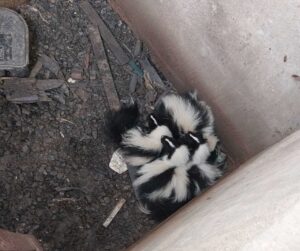 Never attempt to trap or remove skunks by yourself, as they can and will spray if they feel cornered, and they are also armed with sharp teeth and claws that they can lash out with, especially if they are protecting their babies. Skunks can spread rabies through their scratches and bites, so always leave skunk removal to the experts at Westchester Wildlife. Our team will safely and humanely trap and remove skunks, taking special care to remove the skunk babies with their mother. If you need skunk trapping and removal services in Westchester County, NY, Putnam County, NY, Dutchess County, NY, Fairfield County, CT or Litchfield County, CT, contact the experts at Westchester Wildlife today at (914) 760-5713!
Never attempt to trap or remove skunks by yourself, as they can and will spray if they feel cornered, and they are also armed with sharp teeth and claws that they can lash out with, especially if they are protecting their babies. Skunks can spread rabies through their scratches and bites, so always leave skunk removal to the experts at Westchester Wildlife. Our team will safely and humanely trap and remove skunks, taking special care to remove the skunk babies with their mother. If you need skunk trapping and removal services in Westchester County, NY, Putnam County, NY, Dutchess County, NY, Fairfield County, CT or Litchfield County, CT, contact the experts at Westchester Wildlife today at (914) 760-5713!
How To Keep Skunks Out
The best way to deal with a skunk problem is to take preventative measures to keep them from coming to your property in the first place. Keep your trash cans tightly sealed, and do not feed your pet outdoors, as trash cans and pet food bowls are a common food source for skunks. Skunks may wander into your garage, so keep your garage door closed at night. Westchester Wildlife can also help, we can install wildlife barriers underneath your porch, deck, or shed to prevent skunks from digging underneath.
Best Skunk Removal in Westchester County
 Skunks are a common nuisance animal that can douse you and your pets in their overwhelmingly awful scent, which is very difficult to get rid of. Skunks are also known to rip up lawns to search for grubs to eat, and they will knock over your trash cans and get into your garage to search for any pet food you might’ve left out. Skunks can also dig out dens underneath your porch, deck, or inside your crawl space, and they will spray to mark their territory. Don’t try to remove skunks yourself, as they can bite and scratch, and they are common rabies vectors. Westchester Wildlife can help. We offer skunk trapping and removal services in Westchester, as well as skunk exclusions, skunk damage repair and wildlife barriers. Contact us today to get started with a FREE estimate at (914) 760-5713!
Skunks are a common nuisance animal that can douse you and your pets in their overwhelmingly awful scent, which is very difficult to get rid of. Skunks are also known to rip up lawns to search for grubs to eat, and they will knock over your trash cans and get into your garage to search for any pet food you might’ve left out. Skunks can also dig out dens underneath your porch, deck, or inside your crawl space, and they will spray to mark their territory. Don’t try to remove skunks yourself, as they can bite and scratch, and they are common rabies vectors. Westchester Wildlife can help. We offer skunk trapping and removal services in Westchester, as well as skunk exclusions, skunk damage repair and wildlife barriers. Contact us today to get started with a FREE estimate at (914) 760-5713!
 Are Groundhogs Tearing Up Your Yard? Here’s What You Can Do
Are Groundhogs Tearing Up Your Yard? Here’s What You Can Do
 Some of the common signs that you have a groundhog problem in your yard in Westchester include:
Some of the common signs that you have a groundhog problem in your yard in Westchester include:  There are plenty of Do-It-Yourself deterrents for groundhogs on the market in Westchester, but some of them might not work as well as you want them to. Devices that use light, reflection, noise, or vibration might scare groundhogs off initially, but they will just come back once they realize there is no real danger. The same applies for scent-based repellents like castor oil.
There are plenty of Do-It-Yourself deterrents for groundhogs on the market in Westchester, but some of them might not work as well as you want them to. Devices that use light, reflection, noise, or vibration might scare groundhogs off initially, but they will just come back once they realize there is no real danger. The same applies for scent-based repellents like castor oil. 





 Incorrect! Bats are EXTREMELY beneficial to humans and the environment! Bats are excellent pollinators, crucial for the production of over 500 plants, including several important crops like bananas and mangos. In addition to their excellent pollinating, bats are also excellent pest control agents, able to eat as many as 1200 mosquitoes or mosquito-sized insects in a single hour! Bats are crucial to our ecosystem, but they unfortunately are in danger. Bat populations have been dying off due to encroaching human habitats and the spread of white-nose syndrome. This is why bats are federally protected, and must be handled with care. If you have bats nesting inside your attic, contact the experts at Westchester Wildlife. Our company’s owner and founder Jim Driesacker invented the bat-cone, a humane bat exclusion device that allows bats to leave your attic, but not get back inside. Our team utilizes bat-cones to safely remove bats from your attic without any harm. Get in touch with our team today to get started at
Incorrect! Bats are EXTREMELY beneficial to humans and the environment! Bats are excellent pollinators, crucial for the production of over 500 plants, including several important crops like bananas and mangos. In addition to their excellent pollinating, bats are also excellent pest control agents, able to eat as many as 1200 mosquitoes or mosquito-sized insects in a single hour! Bats are crucial to our ecosystem, but they unfortunately are in danger. Bat populations have been dying off due to encroaching human habitats and the spread of white-nose syndrome. This is why bats are federally protected, and must be handled with care. If you have bats nesting inside your attic, contact the experts at Westchester Wildlife. Our company’s owner and founder Jim Driesacker invented the bat-cone, a humane bat exclusion device that allows bats to leave your attic, but not get back inside. Our team utilizes bat-cones to safely remove bats from your attic without any harm. Get in touch with our team today to get started at 

 If you have a squirrel problem on your property in Westchester, don’t attempt to remove them yourself. Squirrels are unpredictable wild animals, and can become aggressive if threatened, especially when their babies are nearby. Squirrels are also adept at hiding their babies within attic insulation, and you might accidentally leave one behind when evicting a squirrel family. Wildlife removal professionals have the proper tools, training, and equipment to safely and carefully remove squirrels from your home in Westchester.
If you have a squirrel problem on your property in Westchester, don’t attempt to remove them yourself. Squirrels are unpredictable wild animals, and can become aggressive if threatened, especially when their babies are nearby. Squirrels are also adept at hiding their babies within attic insulation, and you might accidentally leave one behind when evicting a squirrel family. Wildlife removal professionals have the proper tools, training, and equipment to safely and carefully remove squirrels from your home in Westchester. 
 Removing an animal from your property may sound tempting, but it poses several risks that you might not consider.
Removing an animal from your property may sound tempting, but it poses several risks that you might not consider.  Knowing which situations require a wildlife removal professional can save you time and energy. Wildlife professionals are most helpful for dealing with animals that are living on your property or spending lots of time near your property. Raccoons, squirrels and bats living in your attic, a venomous
Knowing which situations require a wildlife removal professional can save you time and energy. Wildlife professionals are most helpful for dealing with animals that are living on your property or spending lots of time near your property. Raccoons, squirrels and bats living in your attic, a venomous 

 Attics aren’t the only area on your property that nuisance wildlife will hang out in. Groundhogs are known to dig extensive underground burrows on your property, which can destabilize the soil and lead to your foundation cracking and settling. Groundhogs are also infamous for decimating gardens, feeding on the vegetable crops within.
Attics aren’t the only area on your property that nuisance wildlife will hang out in. Groundhogs are known to dig extensive underground burrows on your property, which can destabilize the soil and lead to your foundation cracking and settling. Groundhogs are also infamous for decimating gardens, feeding on the vegetable crops within. 
 Raccoons do not hibernate during the winter, so they have several other body processes to help them survive the freezing temperatures and harsh conditions of winter. Raccoons, when faced with no other options, will enter a state of lowered activity called torpor, which is distinctly different from hibernation.
Raccoons do not hibernate during the winter, so they have several other body processes to help them survive the freezing temperatures and harsh conditions of winter. Raccoons, when faced with no other options, will enter a state of lowered activity called torpor, which is distinctly different from hibernation.  Raccoons are one of the most destructive nuisance wildlife in the Westchester area. Raccoons will exploit the tiniest cracks in your soffit, gable vents, ridge vents, or roof shingles. When a raccoon is nesting inside your attic, you might see damaged soffits, bent or destroyed vents, and missing shingles, signifying where the raccoons are entering and exiting from. Once inside, these critters will start ripping up and shredding your attic insulation, tearing through HVAC ducts, and scratching/gnawing on wooden beams and wires. Raccoons are mostly active at night, so if you are hearing scratching or loud shuffling sounds coming from your attic space, this is a sign that you have raccoons spending the winter in your home.
Raccoons are one of the most destructive nuisance wildlife in the Westchester area. Raccoons will exploit the tiniest cracks in your soffit, gable vents, ridge vents, or roof shingles. When a raccoon is nesting inside your attic, you might see damaged soffits, bent or destroyed vents, and missing shingles, signifying where the raccoons are entering and exiting from. Once inside, these critters will start ripping up and shredding your attic insulation, tearing through HVAC ducts, and scratching/gnawing on wooden beams and wires. Raccoons are mostly active at night, so if you are hearing scratching or loud shuffling sounds coming from your attic space, this is a sign that you have raccoons spending the winter in your home. 
 During the winter, pigeons that are well-adapted to urban and suburban areas will be searching for safe, warm places to begin building their nests. Unfortunately, your home’s attic provides the perfect harborage for these avian pests. Pigeons will nest inside your attic, your dryer vents, your gutters, and any other little pocket they can find in your home. Pigeon nests can be dangerous, as the dry twigs, dead leaves, dead grass and straw can lead to a fire hazard, especially if they are nesting inside your dryer vent. If their nests are inside your attic space, these birds can damage your shingles and your siding as they enter and exit the attic. Pigeons might also rip out your attic insulation to add to their nests, which can decrease the insulation’s ability to resist heat. However, the most significant damage caused by pigeons nesting in your home is through their corrosive droppings. Pigeon droppings are known to contain acidic uric acid, which can eat away at materials like wood, metal, shingles, and paint. Not only can this corrode the structures in your home, it can also lead to unsightly staining.
During the winter, pigeons that are well-adapted to urban and suburban areas will be searching for safe, warm places to begin building their nests. Unfortunately, your home’s attic provides the perfect harborage for these avian pests. Pigeons will nest inside your attic, your dryer vents, your gutters, and any other little pocket they can find in your home. Pigeon nests can be dangerous, as the dry twigs, dead leaves, dead grass and straw can lead to a fire hazard, especially if they are nesting inside your dryer vent. If their nests are inside your attic space, these birds can damage your shingles and your siding as they enter and exit the attic. Pigeons might also rip out your attic insulation to add to their nests, which can decrease the insulation’s ability to resist heat. However, the most significant damage caused by pigeons nesting in your home is through their corrosive droppings. Pigeon droppings are known to contain acidic uric acid, which can eat away at materials like wood, metal, shingles, and paint. Not only can this corrode the structures in your home, it can also lead to unsightly staining.  Pigeons can pose a risk to your home through their flammable nests and their corrosive droppings, and they can also pose a health hazard to you and your family through the various diseases and parasites they carry and spread. If you are hearing pigeon coos and flapping noises coming from your attic, or if you are seeing pigeon droppings and feathers around your property, it’s best to contact a licensed wildlife removal professional like Westchester Wildlife for pigeon removal services immediately. Our team of wildlife experts will carefully inspect your home for signs of pigeons, locating all the entry points and nesting. We will safely and humanely trap and remove all the pigeons on your property, and remediate any damage caused by these pest birds. Additionally, we also offer dead bird removal if you have a dead pigeon inside your home or yard. If you need pigeon removal services in the Westchester area, contact our team today to get on the schedule at
Pigeons can pose a risk to your home through their flammable nests and their corrosive droppings, and they can also pose a health hazard to you and your family through the various diseases and parasites they carry and spread. If you are hearing pigeon coos and flapping noises coming from your attic, or if you are seeing pigeon droppings and feathers around your property, it’s best to contact a licensed wildlife removal professional like Westchester Wildlife for pigeon removal services immediately. Our team of wildlife experts will carefully inspect your home for signs of pigeons, locating all the entry points and nesting. We will safely and humanely trap and remove all the pigeons on your property, and remediate any damage caused by these pest birds. Additionally, we also offer dead bird removal if you have a dead pigeon inside your home or yard. If you need pigeon removal services in the Westchester area, contact our team today to get on the schedule at 



 The biggest risk associated with skunks is the extremely foul-smelling spray they will unleash on whatever is posing a direct threat to them. Thankfully, skunks are not an aggressive animal, and will prefer to run away from a fight. Even if a skunk does spray, it gives plenty of warning signs. Skunks about to spray will adopt a wide stance, raise their tail in the air, and aggressively stomp their feet, so if you see a skunk displaying these behaviors, remove yourself from the situation immediately. Skunk sprays can be a major irritant, affecting the eyes, nose, and respiratory system. The odor is unbearable and can cause nausea, and it is very difficult to get rid of. It’s even more difficult to get rid of when the skunk sprays your dog, as the scent can get trapped in their fur.
The biggest risk associated with skunks is the extremely foul-smelling spray they will unleash on whatever is posing a direct threat to them. Thankfully, skunks are not an aggressive animal, and will prefer to run away from a fight. Even if a skunk does spray, it gives plenty of warning signs. Skunks about to spray will adopt a wide stance, raise their tail in the air, and aggressively stomp their feet, so if you see a skunk displaying these behaviors, remove yourself from the situation immediately. Skunk sprays can be a major irritant, affecting the eyes, nose, and respiratory system. The odor is unbearable and can cause nausea, and it is very difficult to get rid of. It’s even more difficult to get rid of when the skunk sprays your dog, as the scent can get trapped in their fur.  Never attempt to trap or remove skunks by yourself, as they can and will spray if they feel cornered, and they are also armed with sharp teeth and claws that they can lash out with, especially if they are protecting their babies. Skunks can spread rabies through their scratches and bites, so always leave skunk removal to the experts at Westchester Wildlife. Our team will safely and humanely trap and remove skunks, taking special care to remove the skunk babies with their mother. If you need skunk trapping and removal services in Westchester County, NY, Putnam County, NY, Dutchess County, NY, Fairfield County, CT or Litchfield County, CT, contact the experts at Westchester Wildlife today at (914) 760-5713!
Never attempt to trap or remove skunks by yourself, as they can and will spray if they feel cornered, and they are also armed with sharp teeth and claws that they can lash out with, especially if they are protecting their babies. Skunks can spread rabies through their scratches and bites, so always leave skunk removal to the experts at Westchester Wildlife. Our team will safely and humanely trap and remove skunks, taking special care to remove the skunk babies with their mother. If you need skunk trapping and removal services in Westchester County, NY, Putnam County, NY, Dutchess County, NY, Fairfield County, CT or Litchfield County, CT, contact the experts at Westchester Wildlife today at (914) 760-5713! Skunks are a common nuisance animal that can douse you and your pets in their overwhelmingly awful scent, which is very difficult to get rid of. Skunks are also known to rip up lawns to search for grubs to eat, and they will knock over your trash cans and get into your garage to search for any pet food you might’ve left out. Skunks can also dig out dens underneath your porch, deck, or inside your crawl space, and they will spray to mark their territory. Don’t try to remove skunks yourself, as they can bite and scratch, and they are common rabies vectors. Westchester Wildlife can help. We offer skunk trapping and removal services in Westchester, as well as skunk exclusions, skunk damage repair and wildlife barriers. Contact us today to get started with a FREE estimate at (914) 760-5713!
Skunks are a common nuisance animal that can douse you and your pets in their overwhelmingly awful scent, which is very difficult to get rid of. Skunks are also known to rip up lawns to search for grubs to eat, and they will knock over your trash cans and get into your garage to search for any pet food you might’ve left out. Skunks can also dig out dens underneath your porch, deck, or inside your crawl space, and they will spray to mark their territory. Don’t try to remove skunks yourself, as they can bite and scratch, and they are common rabies vectors. Westchester Wildlife can help. We offer skunk trapping and removal services in Westchester, as well as skunk exclusions, skunk damage repair and wildlife barriers. Contact us today to get started with a FREE estimate at (914) 760-5713!